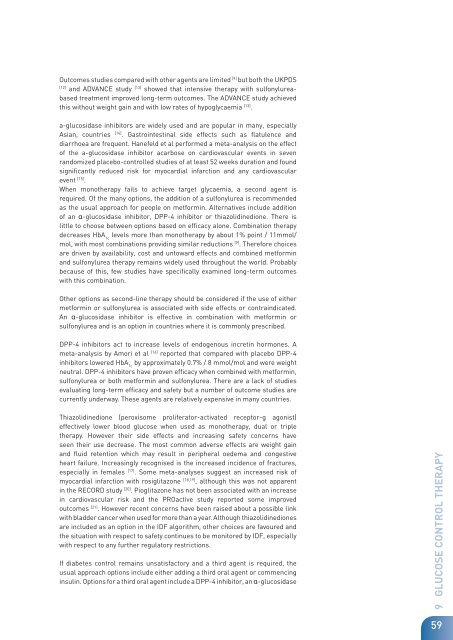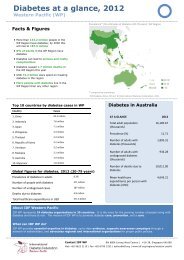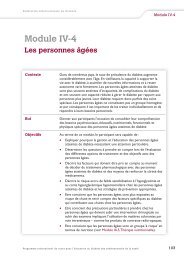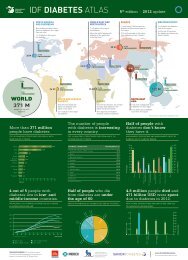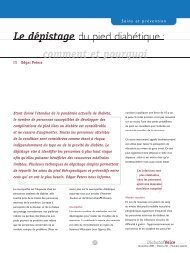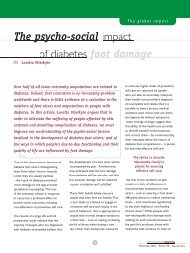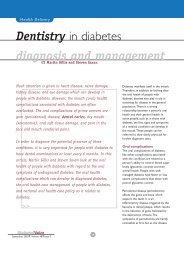Evidence-base - International Diabetes Federation
Evidence-base - International Diabetes Federation
Evidence-base - International Diabetes Federation
You also want an ePaper? Increase the reach of your titles
YUMPU automatically turns print PDFs into web optimized ePapers that Google loves.
Outcomes studies compared with other agents are limited [9] but both the UKPDS<br />
[12] and ADVANCE study [13] showed that intensive therapy with sulfonylurea<strong>base</strong>d<br />
treatment improved long-term outcomes. The ADVANCE study achieved<br />
this without weight gain and with low rates of hypoglycaemia [13] .<br />
a-glucosidase inhibitors are widely used and are popular in many, especially<br />
Asian, countries [14] . Gastrointestinal side effects such as flatulence and<br />
diarrhoea are frequent. Hanefeld et al performed a meta-analysis on the effect<br />
of the a-glucosidase inhibitor acarbose on cardiovascular events in seven<br />
randomized placebo-controlled studies of at least 52 weeks duration and found<br />
significantly reduced risk for myocardial infarction and any cardiovascular<br />
event [15] .<br />
When monotherapy fails to achieve target glycaemia, a second agent is<br />
required. Of the many options, the addition of a sulfonylurea is recommended<br />
as the usual approach for people on metformin. Alternatives include addition<br />
of an α-glucosidase inhibitor, DPP-4 inhibitor or thiazolidinedione. There is<br />
little to choose between options <strong>base</strong>d on efficacy alone. Combination therapy<br />
decreases HbA 1c levels more than monotherapy by about 1% point / 11mmol/<br />
mol, with most combinations providing similar reductions [9] . Therefore choices<br />
are driven by availability, cost and untoward effects and combined metformin<br />
and sulfonylurea therapy remains widely used throughout the world. Probably<br />
because of this, few studies have specifically examined long-term outcomes<br />
with this combination.<br />
Other options as second-line therapy should be considered if the use of either<br />
metformin or sulfonylurea is associated with side effects or contraindicated.<br />
An α-glucosidase inhibitor is effective in combination with metformin or<br />
sulfonylurea and is an option in countries where it is commonly prescribed.<br />
DPP-4 inhibitors act to increase levels of endogenous incretin hormones. A<br />
meta-analysis by Amori et al [16] reported that compared with placebo DPP-4<br />
inhibitors lowered HbA 1c by approximately 0.7% / 8 mmol/mol and were weight<br />
neutral. DPP-4 inhibitors have proven efficacy when combined with metformin,<br />
sulfonylurea or both metformin and sulfonylurea. There are a lack of studies<br />
evaluating long-term efficacy and safety but a number of outcome studies are<br />
currently underway. These agents are relatively expensive in many countries.<br />
Thiazolidinedione (peroxisome proliferator-activated receptor-g agonist)<br />
effectively lower blood glucose when used as monotherapy, dual or triple<br />
therapy. However their side effects and increasing safety concerns have<br />
seen their use decrease. The most common adverse effects are weight gain<br />
and fluid retention which may result in peripheral oedema and congestive<br />
heart failure. Increasingly recognised is the increased incidence of fractures,<br />
especially in females [17] . Some meta-analyses suggest an increased risk of<br />
myocardial infarction with rosiglitazone [18,19] , although this was not apparent<br />
in the RECORD study [20] . Pioglitazone has not been associated with an increase<br />
in cardiovascular risk and the PROactive study reported some improved<br />
outcomes [21] . However recent concerns have been raised about a possible link<br />
with bladder cancer when used for more than a year. Although thiazolidinediones<br />
are included as an option in the IDF algorithm, other choices are favoured and<br />
the situation with respect to safety continues to be monitored by IDF, especially<br />
with respect to any further regulatory restrictions.<br />
If diabetes control remains unsatisfactory and a third agent is required, the<br />
usual approach options include either adding a third oral agent or commencing<br />
insulin. Options for a third oral agent include a DPP-4 inhibitor, an α-glucosidase<br />
9 GLUCOSE CONTROL THERAPY<br />
59


